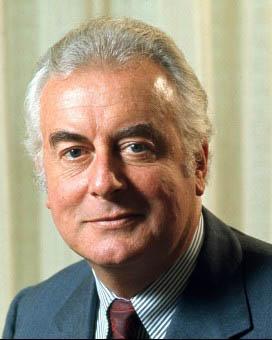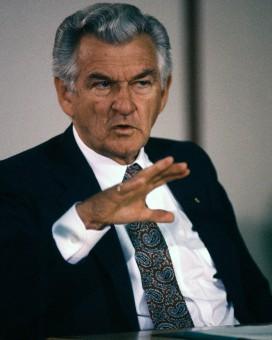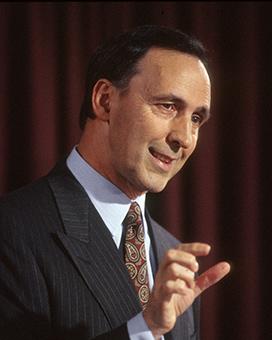John Malcolm Fraser was an Oxford graduate and a grazier when he won the seat of Wannon. Aged 25, he became the youngest member of the 22nd parliament in 1955. For the next 10 years, he was a backbencher in the government of Robert Menzies.
In 1966, Fraser became a minister for the first time when Harold Holt allocated him the Army portfolio. He was Minister for Education and Science (1968–69) in the government of John Gorton, then Minister for Defence. Gorton’s resignation as party leader in 1971 created a Liberal Party crisis in which William McMahon replaced Gorton as Prime Minister. Fraser was Minister for Education and Science until the 1972 election brought the Labor government of Gough Whitlam into power. He then became the Shadow Minister for Industrial Relations. He was the Leader of the Opposition from 21 March to 11 November 1975, when the Governor-General dismissed the Whitlam government and Fraser became caretaker Prime Minister.
Childhood
Fraser was born in Melbourne on 21 May 1930, the youngest of the 2 children of John Neville and Una (Woolf) Fraser. His grandfather, Sir Simon Fraser, had been a Victorian parliamentarian and a delegate to the Australasian Federal Convention in 1897–98. Simon Fraser had joined George Reid’s Free Trade Party in 1901, and was a Senator from 1901 to 1913.
Fraser lived with his parents on their pastoral property on the New South Wales side of the Murray River, north of Deniliquin. When he was 10, he became a boarder at Tudor House primary school in Moss Vale near Sydney. He was a prefect at age 13. In his final year, his headmaster observed that ‘the child gave evidence of developing into a popular and capable leader and was reliable in every way’.
The family bought a new property, ‘Nareen’, in western Victoria in 1946, while Fraser attended Melbourne Grammar. At 19, he studied at Oxford's Magdalen College in England and completed a degree in politics and economics in 1952. At the age of 22, Fraser returned to Australia to work on ‘Nareen’, and joined the local branch of the Liberal Party, formed by Robert Menzies in 1944.
Member for Wannon
In May 1954, a week after his 24th birthday, Fraser stood unsuccessfully for the House of Representatives seat of Wannon. This was the election held immediately after the defection in Canberra of Soviet officials Vladimir and Evdokia Petrov. Labor polled well in this election, taking 5 seats from the Liberal Party. Don McLeod, the sitting Labor Member for Wannon, was returned.
Early the next year, the Labor Party split and an anti-Communist Labor Party formed. Prime Minister Robert Menzies secured an early dissolution of parliament, and another federal election was held in December 1955. This time the Coalition won 10 seats from Labor. Among those won on the preferences of the anti-Communist Labor Party was the seat of Wannon, which went to Fraser.
When the Governor-General, Sir William Slim, opened the new parliament on 15 February 1956, 25-year-old Malcolm Fraser was the youngest member. Robert Menzies’ Minister for External Affairs, RG (Richard) Casey, had family connections with the Frasers and remained a friend of Fraser.
Fraser married Tamara (Tamie) Beggs in 1957, one day short of his first parliamentary anniversary. Her family also ran a western Victorian property. The following year, the couple moved to Canberra. At first, the city was their home only during parliamentary sessions but, within a few years, Canberra became the family home during school terms too.
As a backbencher, Fraser served on the Parliamentary Joint Committee on Foreign Affairs from 1962. With their 2 younger children at school, in 1964 Malcolm and Tamie Fraser made an official trip overseas. Fraser had been one of 2 parliamentarians to win a grant to study overseas, and in Washington DC he studied US policy development. The other grant was won by Labor Member Gough Whitlam, who already was on far-from-friendly terms with Fraser.
Army Minister 1966–68
On Robert Menzies’ retirement in 1966, Prime Minister Harold Holt appointed Fraser to his first ministry. Like Menzies, Holt had an inner Cabinet of 12, and an outer ministry. He included Annabelle Rankin as Housing Minister and Fraser as Army Minister in his outer ministry of 13.
Fraser was Army Minister for 2 years (1966–68), under 3 prime ministers. After the death of Harold Holt in December 1967, John McEwen was briefly caretaker Prime Minister, until John Gorton was sworn in on 10 January 1968. The 1967–68 period was the early stage of Australia’s combat involvement in the Vietnam War. The first Australian troops had been despatched by the Menzies government in May 1965. In his first year as Army Minister, Fraser visited the troops in Vietnam and also made official visits to Thailand, Laos, Malaysia and the Philippines. He established a good working relationship with Army Chief of Staff General Thomas Daly and with Defence Minister Allen Fairhall.
Minister for Education and Science 1968–69
John Gorton reshuffled Cabinet a month after he became Prime Minister and allocated the portfolio of Education and Science to Malcolm Fraser. Although still an outer portfolio, this was a period of expanding departmental responsibilities, with growth in tertiary education and increased government funding to private schools.
In 1969, Fraser represented the Gorton government at Singapore’s 150th anniversary celebrations and led an Australian cultural mission to Italy.
Minister for Defence 1969–71
After 14 years as a government member of the House of Representatives, Fraser finally became a member of the Cabinet. John Gorton allocated him the Defence portfolio after the federal election in October 1969, during the Vietnam War. Fraser, however, developed an uneasy relationship with his Prime Minister and early in 1971 their disagreements reached a critical point. Fraser accused Gorton of disloyalty to him in a conflict with senior Army officials. On 8 March 1971, Fraser resigned from the Defence portfolio. Like Joseph Lyons and Robert Menzies before him, Fraser’s resignation from Cabinet precipitated his Prime Minister’s demise.
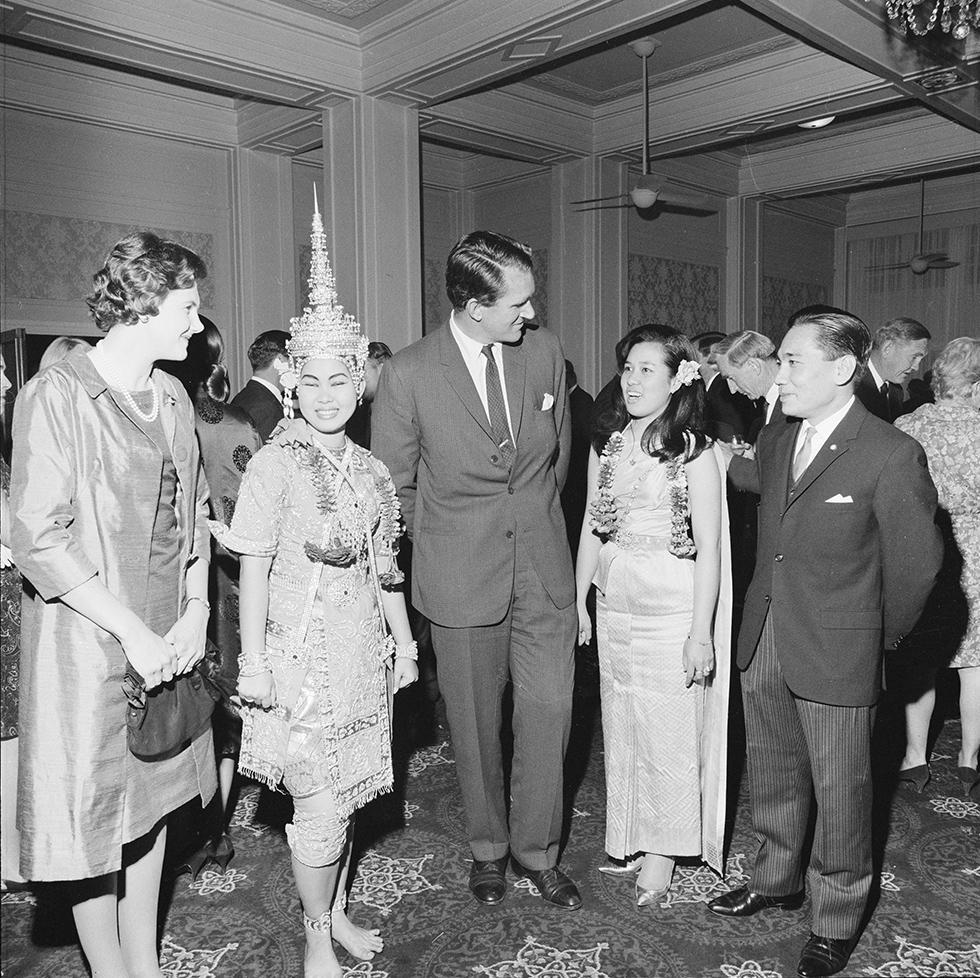
Thai guests with Army Minister Malcolm Fraser (centre) and Tamie Fraser celebrating the birthday of the King of Thailand in Canberra, 1966. John Gorton is in the background (right). NAA: A1501, A6974/1
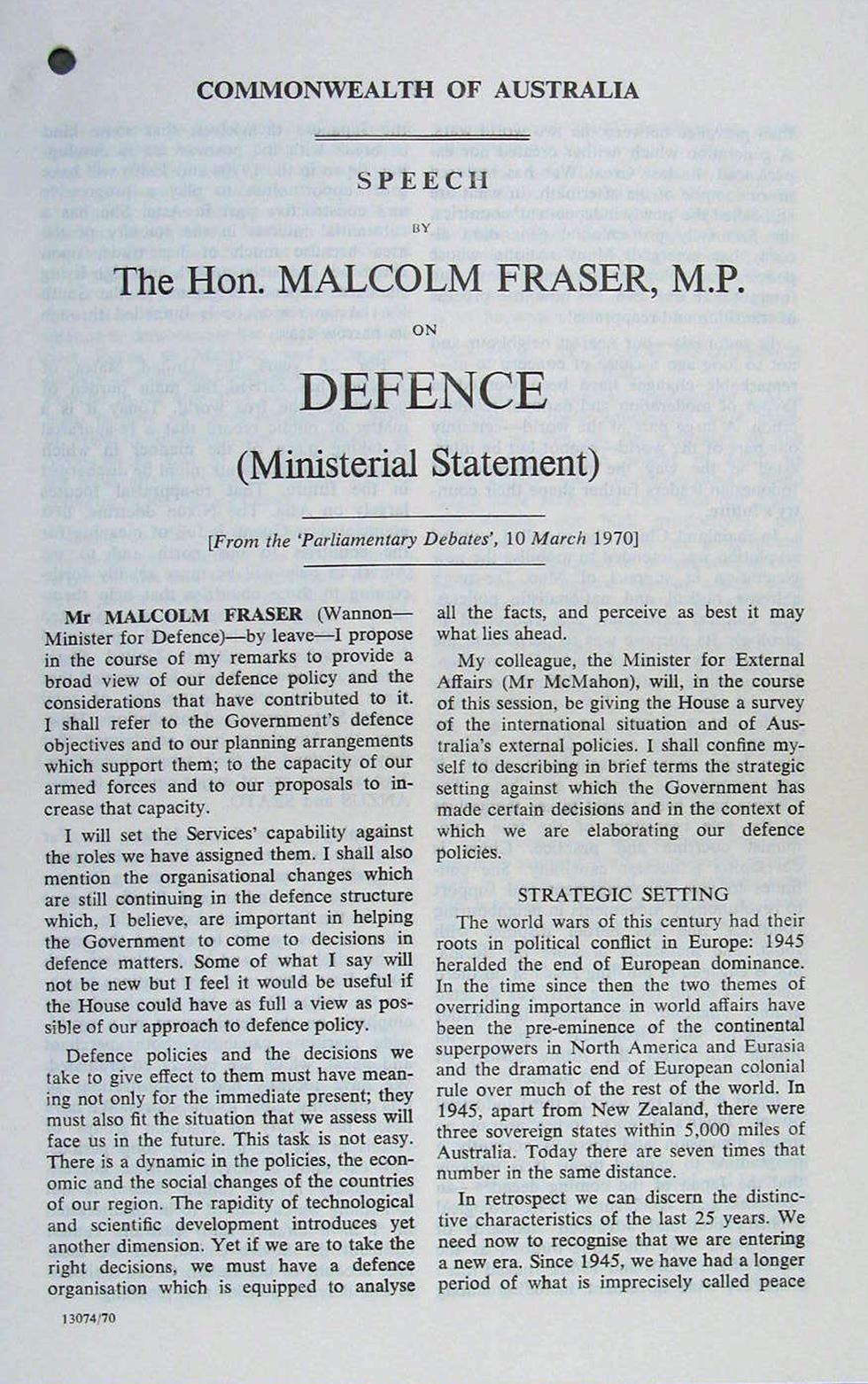
Statement to the House of Representatives by Malcolm Fraser, the Minister for Defence, 10 March 1970. NAA: A5954, 99/7, p.2
Minister for Education and Science 1971–72
William McMahon replaced John Gorton as party leader and became Prime Minister on 10 March 1971. McMahon appointed Fraser as Minister for Education and Science in August 1971, after Gorton resigned from Cabinet and David Fairbairn moved from Education to replace Gorton as Minister for Defence.
Fraser served under 5 prime ministers in his 7 years as a minister. McMahon was the last, as the Coalition’s 23 years in government ended in 1972.
In Opposition 1972–75
When the Labor Party won the federal election on 2 December 1972, Fraser moved to the Opposition benches for the first time in his parliamentary career. The Frasers also moved their home back to Victoria.
On 3 August 1973, Billy Snedden, who replaced William McMahon as Liberal Party leader, appointed Fraser Shadow Minister for Industrial Relations. Fraser developed a cordial relationship with the Minister, Clyde Cameron, but his relations with Snedden were less warm. In 1971, Fraser had outlined his vision of a Liberal leader as ‘tough, bold, and philosophical’ at the 5th Alfred Deakin lecture. In July 1974, Fraser used his speech at a commemorative dinner at the Royal Melbourne Institute of Technology to contrast the ideals and realities of Liberal leadership. In August, he wrote an article for the Melbourne Herald arguing that the Liberal Party had lost its sense of purpose and direction, and needed a leader who would re-assert Liberal principles. He pursued this theme in his Robert Garran memorial lecture the same year and in an article in Australian Quarterly.
With shadow minister Tony Street and party official David Kemp on his side, Fraser’s first leadership attempt on 26 November 1974 was followed by months of less direct challenges to Snedden. Then, on 21 March 1975, a leadership ballot was held and Snedden was defeated by Fraser, with Phillip Lynch remaining Deputy Leader.
With Fraser as Leader of the Opposition and Gough Whitlam as Prime Minister, the 2 men who as backbenchers had been awarded leadership grants 10 years before, were now antagonists on the floor of the House of Representatives. The contest was brief. With control of the Senate, the Coalition blocked Supply Bills in September 1975, effectively cutting off government funds.
In a controversial decision on 11 November 1975, the Governor-General Sir John Kerr dismissed the Whitlam government and appointed Fraser as caretaker Prime Minister. When the new parliament met in February 1976, former Liberal leader Billy Snedden became Speaker of the House of Representatives, retaining the position for the next 7 years.
Sources
- Ayres, Philip, Malcolm Fraser: A Biography, William Heinemann Australia, Melbourne, 1987.
- Edwards, John, Life Wasn’t Meant to be Easy: A Political Profile of Malcolm Fraser, Mayhem, Sydney, 1977.


